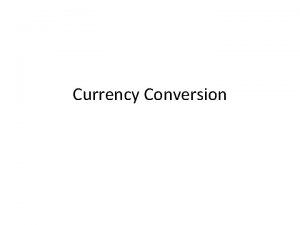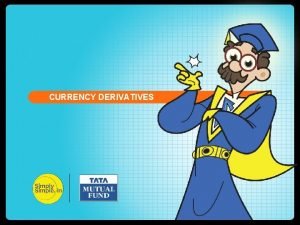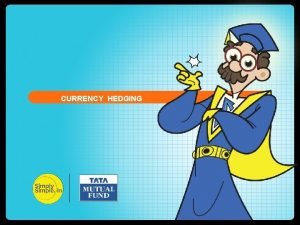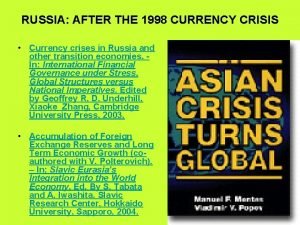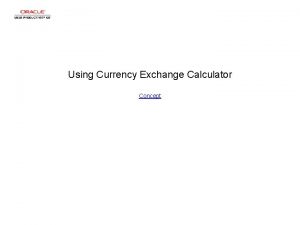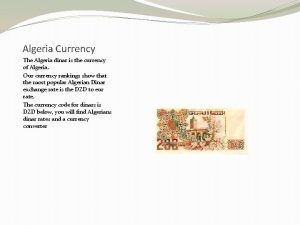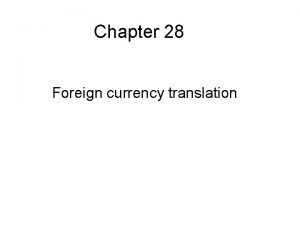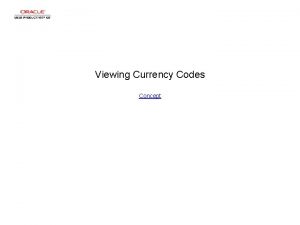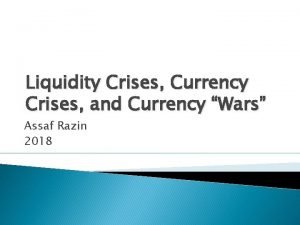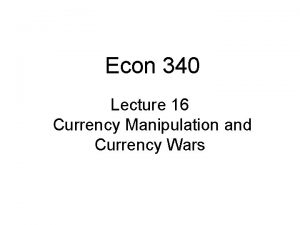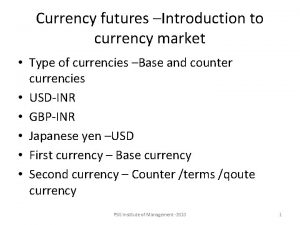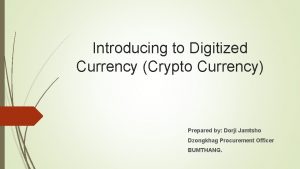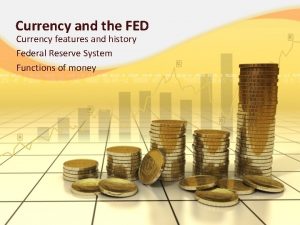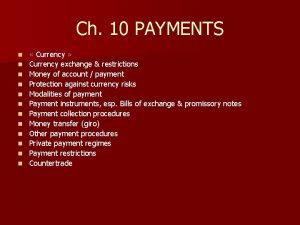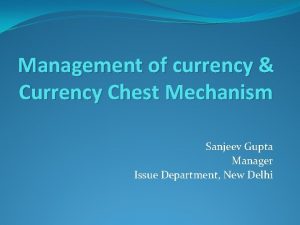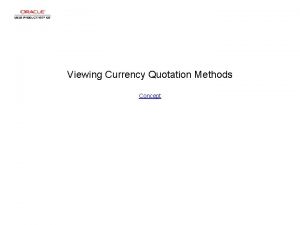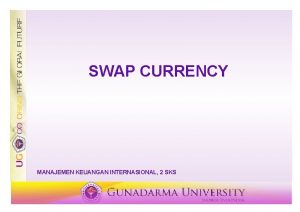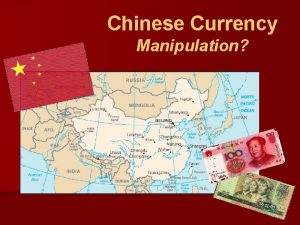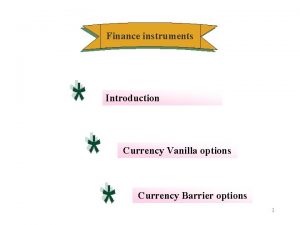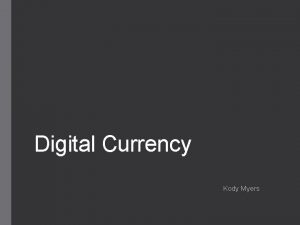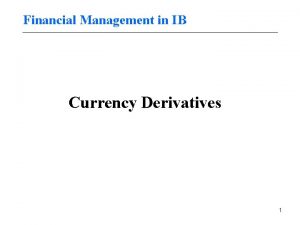SD determine currency strengths What if the U
![[“S&D” determine currency strengths] [What if the U. S. wants more Mazdas from Japan? [“S&D” determine currency strengths] [What if the U. S. wants more Mazdas from Japan?](https://slidetodoc.com/presentation_image/4aae987b4372aba790db0e66c750bd9e/image-1.jpg)
![[“S&D” determine currency strengths] [What if the Europeans want more American cars? ] United [“S&D” determine currency strengths] [What if the Europeans want more American cars? ] United](https://slidetodoc.com/presentation_image/4aae987b4372aba790db0e66c750bd9e/image-2.jpg)
![[Percent change from 8/11/97 to 8/11/98] So – currency prices can be very volatile. [Percent change from 8/11/97 to 8/11/98] So – currency prices can be very volatile.](https://slidetodoc.com/presentation_image/4aae987b4372aba790db0e66c750bd9e/image-3.jpg)
![[Now it is $1, 171 Dinars = $1] [Now it is $1, 171 Dinars = $1]](https://slidetodoc.com/presentation_image/4aae987b4372aba790db0e66c750bd9e/image-4.jpg)





![Reason for: Downward Sloping “D” Curve [As Euro price decreases, QD for $’s increase] Reason for: Downward Sloping “D” Curve [As Euro price decreases, QD for $’s increase]](https://slidetodoc.com/presentation_image/4aae987b4372aba790db0e66c750bd9e/image-10.jpg)
![Reason for: Upward Sloping “S” Curve [As Euro price increases, QS of dollars increase] Reason for: Upward Sloping “S” Curve [As Euro price increases, QS of dollars increase]](https://slidetodoc.com/presentation_image/4aae987b4372aba790db0e66c750bd9e/image-11.jpg)
![D 1 APPRECIATION Or DEPRECIATION Euro Price of $ [Euros looking for $’s] € D 1 APPRECIATION Or DEPRECIATION Euro Price of $ [Euros looking for $’s] €](https://slidetodoc.com/presentation_image/4aae987b4372aba790db0e66c750bd9e/image-12.jpg)



![Therefore, it takes fewer pennies, so the dollar is stronger [$ price decreases] Therefore, Therefore, it takes fewer pennies, so the dollar is stronger [$ price decreases] Therefore,](https://slidetodoc.com/presentation_image/4aae987b4372aba790db0e66c750bd9e/image-16.jpg)










![Therefore, it takes fewer pennies, so the dollar is stronger [$ price decreases] Therefore, Therefore, it takes fewer pennies, so the dollar is stronger [$ price decreases] Therefore,](https://slidetodoc.com/presentation_image/4aae987b4372aba790db0e66c750bd9e/image-27.jpg)





![Balance of Trade in Goods [“R” is Recession] D 1 $1. 50 $1. 00 Balance of Trade in Goods [“R” is Recession] D 1 $1. 50 $1. 00](https://slidetodoc.com/presentation_image/4aae987b4372aba790db0e66c750bd9e/image-33.jpg)
![As Interest Rates Rose. . . [all the way to 13%] “Strong Dollar” The As Interest Rates Rose. . . [all the way to 13%] “Strong Dollar” The](https://slidetodoc.com/presentation_image/4aae987b4372aba790db0e66c750bd9e/image-34.jpg)
![Appreciation/Depreciation NS [14 -19] 14. If the dollar depreciates relative to the peso, peso Appreciation/Depreciation NS [14 -19] 14. If the dollar depreciates relative to the peso, peso](https://slidetodoc.com/presentation_image/4aae987b4372aba790db0e66c750bd9e/image-35.jpg)

![Winners [anyone buying with dollars] 1. American tourists to Mexico 2. People who send Winners [anyone buying with dollars] 1. American tourists to Mexico 2. People who send](https://slidetodoc.com/presentation_image/4aae987b4372aba790db0e66c750bd9e/image-37.jpg)


- Slides: 39
![SD determine currency strengths What if the U S wants more Mazdas from Japan [“S&D” determine currency strengths] [What if the U. S. wants more Mazdas from Japan?](https://slidetodoc.com/presentation_image/4aae987b4372aba790db0e66c750bd9e/image-1.jpg)
[“S&D” determine currency strengths] [What if the U. S. wants more Mazdas from Japan? ] United States Japan
![SD determine currency strengths What if the Europeans want more American cars United [“S&D” determine currency strengths] [What if the Europeans want more American cars? ] United](https://slidetodoc.com/presentation_image/4aae987b4372aba790db0e66c750bd9e/image-2.jpg)
[“S&D” determine currency strengths] [What if the Europeans want more American cars? ] United States Europe
![Percent change from 81197 to 81198 So currency prices can be very volatile [Percent change from 8/11/97 to 8/11/98] So – currency prices can be very volatile.](https://slidetodoc.com/presentation_image/4aae987b4372aba790db0e66c750bd9e/image-3.jpg)
[Percent change from 8/11/97 to 8/11/98] So – currency prices can be very volatile. Canada’s Dollar [“Loonie”] -8. 5% Indonesia’s Rupiah -80. 6% Japanese Yen -21. 2% Thailand’s Baht -26. 3% Mexico’s Peso -15. 2% South Korean Won -33. 3%
![Now it is 1 171 Dinars 1 [Now it is $1, 171 Dinars = $1]](https://slidetodoc.com/presentation_image/4aae987b4372aba790db0e66c750bd9e/image-4.jpg)
[Now it is $1, 171 Dinars = $1]

The New Iraqi Dinar – No Saddam

Seven Euro Bank Notes On January 1, 2002, 300 million Europeans in 12 countries woke up to a new currency, the euro. 1. Windows and gateways dominate the front side of each note as symbols of EU spirit of openness and cooperation On the back side is a bridge from a particular age, a metaphor for communication among the people of Europe and between Europe and the rest of the world. 2. Sign – was inspired by the Greek letter epsilon, Greek letter epsilon in reference to the cradle of European civilization and the first letter of the word “Europe” The parallel lines represent the stability of the euro 3. Eight denominations of euro coins, Eight denominations of euro coins each having a common side and a national side.

1 cent 2 cents 10 cents 20 cents 1 Euro 5 cents 50 cents 2 Euro coin


Foreign Currency per U. S. Dollar (2/5/13) $1 will buy EXCHANGE RATES: 53. 59 Indian rupee. 63 British pounds 1. 00 Canadian dollars 12. 91 Mexican pesos 1. 36 Swiss francs. 75 European euros 92. 71 Japanese yen. 0009 South Korean won 6. 44 Swedish krona 6. 23 Chinese Yuan
![Reason for Downward Sloping D Curve As Euro price decreases QD for s increase Reason for: Downward Sloping “D” Curve [As Euro price decreases, QD for $’s increase]](https://slidetodoc.com/presentation_image/4aae987b4372aba790db0e66c750bd9e/image-10.jpg)
Reason for: Downward Sloping “D” Curve [As Euro price decreases, QD for $’s increase] s Euro Price of $ D [E ur os 150 [Dollars looking for Euros] lo ok in g 100 fo rd ol la rs 50 QD$ QD$ Quantity of Dollars
![Reason for Upward Sloping S Curve As Euro price increases QS of dollars increase Reason for: Upward Sloping “S” Curve [As Euro price increases, QS of dollars increase]](https://slidetodoc.com/presentation_image/4aae987b4372aba790db0e66c750bd9e/image-11.jpg)
Reason for: Upward Sloping “S” Curve [As Euro price increases, QS of dollars increase] D Euro Price of $ [Euros looking for $’s] 150 [D oll ar s s loo ki ng 100 50 QS$ QS$ Quantity of Dollars fo re ur os
![D 1 APPRECIATION Or DEPRECIATION Euro Price of Euros looking for s D 1 APPRECIATION Or DEPRECIATION Euro Price of $ [Euros looking for $’s] €](https://slidetodoc.com/presentation_image/4aae987b4372aba790db0e66c750bd9e/image-12.jpg)
D 1 APPRECIATION Or DEPRECIATION Euro Price of $ [Euros looking for $’s] € 150 € 100 € 50 D D 3 A D 2 s [Dollars looking for Euros] E 2 M will increase E 1 E 3 X will increase D # of Dollars A Dollar Price of Europeans decide to buy more American cars. $1. 50 D 1 Europeans decide to buy fewer American cars. S [Euros looking for Dollars] [Dollars looking for Euros] $1. 00 $. 50 D # of Euros A

Increase in U. S. Growth Rate (Y) [We buy more from Japan appreciating the yen and depreciating the dollar] The country who initiates the action (buying foreign goods, investing based on higher initiates interest rates in foreign country, etc. ) is the country whose supply of currency moves. supply Price of D 1 “We want more Japanese cars, computers, DVD players, digital cameras, and camcorders. ” D 2 S $1. 50 D $1. 00 “Booming” Economy AS AD 2 AD 1 YR Y* # of A

Decrease in U. S. Growth Rate (Y) Recessionary Economy [We buy less from Japan AS AD 1 depreciating the yen and AD 2 PL appreciating the dollar] YR Y* Price of $1. 00 D 1 50¢ A S D 2 D Quantity of “Seven million of us have lost our jobs. We can’t buy as many American or Japanese products. ”

1. Cheaper goods (lower prices) prices 2. High interest rates 3. Popular items (Taste) This is because money is good for: I’m a. Stuff now so cheaper prices are more beneficial. “supplying” b. Popular items are also stuff wanted now as they are blows. also perceived to be more beneficial. c. Stuff later (in which case you need more money) money , and the way you get more money is to loan it, hence benefiting from a higher interest rate. Again, remember, the country who initiates the action: a. buying more foreign goods [because of taste, lower PL, or more income], b. invests more based on higher interest rates overseas, etc. c. is the country whose supply of currency moves I (The country being acted upon, upon is the country “demand” whose demand for their currency moves. ) moves that you stop.
![Therefore it takes fewer pennies so the dollar is stronger price decreases Therefore Therefore, it takes fewer pennies, so the dollar is stronger [$ price decreases] Therefore,](https://slidetodoc.com/presentation_image/4aae987b4372aba790db0e66c750bd9e/image-16.jpg)
Therefore, it takes fewer pennies, so the dollar is stronger [$ price decreases] Therefore, it takes more pennies, so the dollar is weaker. [$ price increases]

Remember this: “Both the demand the supply curves for the different currencies must shift in the same direction" direction

D 2 1. Show an “ increase in taste” $1. 50 $1 for Japanese cars would affect the market for the Yen and the Dollar. S e 1 e 2 Appreciate D Yen Price of $ $ Price of Yen D ¥ 100 ¥ 50 2. How would an increase in Mexico’s real interest rate affect the value of real interest rate the Peso and the value of the Euro? S e 2 € 150 e 1 € 100 Appreciate D 2 e 1 Depreciate $1 $. 50 e 2 # of Won D ¥ 100 ¥ 50 D W 1, 070 W 1, 030 S S 2 e 1 e 2 $1. 50 Depreciate $1. 00 # of Dollars S S 2 e 1 e 2 Depreciate P 16 P 12 Won Price of $ S $ Price of Yen 4. How would a U. S. economic expansion affect the value of the expansion Dollar and the value of the Yen? Yen Price of $ 3. How would high inflation in South Korea affect the market for the Won and the Dollar? $ Price of Won # of Pesos D e 1 Depreciate e 2 # of Dollars Peso Price of Euro Price of Peso # of Yen D D 2 S S 2 # of Euros S 2 D S e 2 e 1 Appreciate # of Dollars D D 2 S e 2 Appreciate e 1 # of Yen

More Fun with the Foreign Exchange Market What shifts the demand supply curves in the FOREX

Market for Dollars ¥ price of $ D$1 D$2 ¥ 150 ¥ 100 Market for Yen S$1 $ price of ¥ D¥ 1 D $1. 00 $. 50 Q$1 Q$2 Quantity of Dollars A S¥ 1 S¥ 2 A Q¥ 1 Q¥ 2 Japan D Quantity of Yen The Fed “Now we have more Yen!” 5. There is an increase in Taste for U. S. Goods by the Japanese. for U. S. Goods/Services become more desirable because of uniqueness or increased quality.

Market for Dollars ¥ price of $ D$2 D$1 S $1 Market for Yen $ price of ¥ ¥ 150 D ¥ 100 $1. 00 $. 50 Q$ 1 Q$ 2 Quantity of Dollars A D¥ 1 S¥ 2 A Q¥ 1 Q¥ 2 Japan D Quantity of Yen The Fed “Again we have more Yen!” 6. Interest Rates in the U. S. INCREASE relative to Japan’s I. R. NCREASE This impacts demand for interest rate sensitive financial investments in the two countries like bonds and CDs.

Market for Dollars ¥ price of $ D$1 ¥ 100 ¥ 50 A Market for Yen S $1 S $2 Q$1 Q$2 Quantity of Dollars D $ price of ¥ $1. 50 $1. 00 D¥ 1 D¥ 2 S ¥ 1 D Japan Q¥ 1 Q¥ 2 Quantity of Yen A Bank of Japan “Japanese banks have more dollars!” 7. There is a change in consumer preferences [ change in consumer preferences Taste] for Japanese cars, computers and airplanes by Americans. cars, computers and airplanes Japanese Goods become more desirable because of uniqueness or increased quality.

Market for Dollars ¥ price of $ D$ 1 ¥ 100 ¥ 50 A S$1 S$2 Market for Yen $ price of ¥ D$2 D$ 1 S¥ 1 $1. 50 $1. 00 D Japan Q$1 Q$2 D Quantity of Dollars Q¥ 1 Q¥ 2 Quantity of Yen A Bank of Japan “Japanese banks have more dollars!” 8. The U. S. economy is in a strong recovery after the GREAT RECESSION. GDP, or National Income, in the U. S. is now HIGHER and Americans on average have more disposable income.

Market for Dollars P price of $ D$1 D$ 2 S$1 Market for Pesos $ price of P P 150 P 100 D $1. 00 $. 50 Q$1 Q$2 Quantity of Dollars A D P 1 S P 2 A QP 1 QP 2 D Quantity of Pesos Mexico The Fed “We now have more Pesos” 9. Due to a recession in the U. S. the Price Level in the U. S. is now LOWER relative to the Price Level in Mexico. LOWER

Market for Dollars ¥ price of $ D$2 D$1 S$1 Market for Yen $ price of ¥ ¥ 150 D ¥ 100 D¥ 1 $1. 00 $. 50 A Q$ 1 Q$ 2 Quantity of Dollars A S¥ 1 S¥ 2 Q¥ 1 Q¥ 2 Japan DQuantity of Yen The Fed “We now have more Yen” 10. The Japanese economy is in recovery. GDP, or National Income, in Japan is now HIGHER and the Japanese on average have more disposable income.

Market for Yen Market for Dollars ¥ price of $ D$1 ¥ 100 ¥ 50 A S $1 S$2 Q$1 Q$2 DQuantity of Dollars $ price of ¥ D¥ 2 D¥ 1 S ¥ 1. 50 D ¥ 1. 00 Japan Q¥ 1 Q¥ 2 Quantity of Yen A Bank of Japan “Japanese banks have more dollars!” 11. Due to a serious recession in Japan, the Price Level in the U. S. is now HIGHER relative to the Price Level in Japan six months ago. HIGHER
![Therefore it takes fewer pennies so the dollar is stronger price decreases Therefore Therefore, it takes fewer pennies, so the dollar is stronger [$ price decreases] Therefore,](https://slidetodoc.com/presentation_image/4aae987b4372aba790db0e66c750bd9e/image-27.jpg)
Therefore, it takes fewer pennies, so the dollar is stronger [$ price decreases] Therefore, it takes more pennies, so the dollar is weaker. [$ price increases]

The Market for Dollars Yen Price of Dollar Exchange Rate: $1 = ¥ 100 P Appreciation of the Dollar Increase in taste for U. S. goods Increase in U. S. Interest Rates Decrease in U. S. Price Level Decrease in U. S. Growth Rate Decrease in U. S. Currency Price D 1 $ D 2 Y looking for $’s ¥ 150 ¥ 100 D A S$ $’s looking for Y E 2 Yen depreciates Yen E 1 appreciates ¥ 50 E 3 Depreciation of Dollar Decrease in Taste 0 Decrease in In. Rates Increase Price Level Increase Growth Rate Increase in Currency Price D D 3 Qe Quantity of Dollars A

Appreciation/Depreciation Japan will supply Price D 1$ D 2 less yen for dollars. ¥/$ S 2¥ $/¥ D¥ $1. 50 ¥ 150 E 2 D A E 2 S 1¥ S 2¥ ¥ 100 ¥ looking for $’s D A Yen E 1 [Exchange Rate: $1 = Y 100] $’s looking for ¥ U. S. will supply more $s for ¥. E 2 S$ S$ ¥/$ D$ ¥ 150 E 2 S ¥ 100 appreciates D # of ¥ A ¥ 50 Japan will supply more yen for dollars. E 3 X M D + + + Yen depreciates S$ - ¥ 50 Currency Price E 2 U. S. will supply fewer $s for ¥. A M X Taste [products/assets] Interest Rates Price Level Growth Rate $ D # of Dollars A D 3 Quantity of Dollars D A + + + -

Rupee Price of Dollar Price R 100 R 50 D 1 $ S 1$ R’s looking for $’s looking for R’s Rupee A S 2 $ E 1 appreciates R 25 D E 2 Quantity of Dollars (c) Using a correctly labeled graph of the foreign exchange market for the U. S. dollar, show an increase in U. S. firms’ direct investment in India will increase in U. S. firms’ direct investment in India affect the value of the U. S. dollar relative to the Indian currency (the rupee). Answer to 2. (c): The increase in investment in India will increase demand for the rupee & appreciate that currency. This would result in an increase in supply of the U. S. dollar for more rupees, depreciating the dollar.

Price D 1 $ Peso Price of Dollar P P 100 P 50 looking for S 2$ $’s S 1$ looking for P E 2 D Peso depreciates E 1 Quantity of Dollars Answer to 3. (c) (i): If the U. S. decrease financial investment in Argentina, the U. S. would decrease their supply of dollars to Argentina, resulting in a decrease in demand for the peso. (c) (ii) As shown on the graph, the dollar would appreciate. (d) The cheaper prices in the U. S. will result in more demand for U. S. goods and therefore the dollar, appreciating the dollar and depreciating the peso. A 3. (c) [2 pt] Using a correctly labeled graph of the foreign exchange market for the U. S. [2 pt] dollar, show a decrease in the U. S. financial investment in Argentina affects each. decrease in the U. S. financial investment in Argentina (i) The supply of United States dollars (ii) The value of the United States dollar relative to the peso (d) [2 pt] Suppose that the inflation rate is 3% in the U. S. and 5% in Argentina. [2 pt] inflation rate is 3% in the U. S. and 5% in Argentina What will happen to the value of the peso relative to the United States dollar as a result of the difference in inflation rates? Explain.

Currency Appreciation and Depreciation D D 2 S $1. 50 D $1. 00 . 50 Dollar price of another currency [yen] International value of dollar falls (dollar depreciates) Equals Exports increase Imports decrease Equals International increases [$1 to $1. 50] A D 3 # of Yen Dollar price of another Currency [yen] decreases [$1 to. 50] value of dollar rises (dollar appreciates) Imports increase Exports decrease
![Balance of Trade in Goods R is Recession D 1 1 50 1 00 Balance of Trade in Goods [“R” is Recession] D 1 $1. 50 $1. 00](https://slidetodoc.com/presentation_image/4aae987b4372aba790db0e66c750bd9e/image-33.jpg)
Balance of Trade in Goods [“R” is Recession] D 1 $1. 50 $1. 00 D 2 S D A. 50 D 3 D # of Yen. A “Direct” relationship between “Y” & “M”
![As Interest Rates Rose all the way to 13 Strong Dollar The As Interest Rates Rose. . . [all the way to 13%] “Strong Dollar” The](https://slidetodoc.com/presentation_image/4aae987b4372aba790db0e66c750bd9e/image-34.jpg)
As Interest Rates Rose. . . [all the way to 13%] “Strong Dollar” The dollar got stronger and stronger 81 82 83 84 85 Exports “Exports decreased. Agricultural exports dropped from $44 billion to $28 billion as foreign agricultural goods became cheaper. ” [Decreased] 81 82 83 84 85 Imports increased as they became cheaper. [Increased] 81 82 83 84 85
![AppreciationDepreciation NS 14 19 14 If the dollar depreciates relative to the peso peso Appreciation/Depreciation NS [14 -19] 14. If the dollar depreciates relative to the peso, peso](https://slidetodoc.com/presentation_image/4aae987b4372aba790db0e66c750bd9e/image-35.jpg)
Appreciation/Depreciation NS [14 -19] 14. If the dollar depreciates relative to the peso, peso the peso will (appreciate/depreciate) relative to the dollar. 15. Appreciation of the dollar will tend to (increase/decrease) American imports & (increase/decrease) American exports. 16. The yen price of the dollar has decreased from ¥ 150=$1 to ¥ 100=$1, ¥ 100=$1 which means the dollar (apprec/deprec), which (incr/decr) our imports from Japan. 17. Depreciation of the euro will (increase/decrease) European exports & (increase/decrease) their imports 18. If Mexico decides to increase their investments in the U. S. , U. S. the peso will (appreciate/depreciate) which would (increase/decrease) [Mexico’s imports] imports U. S. exports to Mexico. 19. If the exchange rate changes so that more Japanese yen are required to buy a dollar then the yen will (appreciate/depreciate) and Americans will purchase (more/less) Japanese goods.

20. If Americans increase their investments in Europe, Europe then the supply of dollars in European banks will (incr/decr) & the dollar will (apprec/deprec). 21. If Europeans quadrupled their investments in the U. S. stock market, market the supply of Euros in U. S. banks would (incr/decr) & the dollar would (appr/depr). 22. Under a system of freely floating exchange rates, an increase in the international value of a nation’s currency will cause its (exports/imports) to increase. 23. If the exchange rate changes so that fewer dollars are required to buy a yen, yen the dollar will (appr/depr) & (fewer/more) U. S. goods will be exported to Japan. 24. If the dollar price of yen increases, increases then the dollar (appreciates/depreciates) relative to the yen and our exports to Japan (increase/decrease). 25. If Mexico’s price level is increasing faster than that of the U. S. , U. S. the peso will (appr/depr) and their exports to the U. S. [our imports] will (incr/decr). 26. If German’s growth rate[income] is increasing faster than that of Mexico, Mexico the euro will (apprec/deprec) & Germany’s exports to Mexico will (incr/decr). 27. If interest rates are decreasing faster in Italy relative to Mexico, Mexico the euro will (appreciate/depreciate) and Italy’s exports to Mexico will (incr/decr). 28. If the dollar price of the yen decreases, decreases the dollar (appreciates/depreciates) relative to the yen and American exports to Japan (increase/decrease). 29. If the dollar price of the euro decreases, decreases our imports from Europe (incr/decr). 30. If the exchange rate changes from $1=¥ 200 to $1=¥ 100, $1=¥ 100 we can say the dollar has (apprec/deprec) in value & Japan’s exports to the U. S. (incr/decr). 31. Depreciation of the euro relative to the U. S. dollar would make a trip by an American to Europe (more/less) expensive. 32. Suppose that yesterday $1 would buy 800 South Korean won, won but today will buy 810 won We can conclude that the won has (depr/apprec) in value.
![Winners anyone buying with dollars 1 American tourists to Mexico 2 People who send Winners [anyone buying with dollars] 1. American tourists to Mexico 2. People who send](https://slidetodoc.com/presentation_image/4aae987b4372aba790db0e66c750bd9e/image-37.jpg)
Winners [anyone buying with dollars] 1. American tourists to Mexico 2. People who send dollars to family or friends in Mexico 3. U. S. businesses that buy from Mexico 4. American consumers who buy Mexican imports 5. Those who primarily do business in dollars Losers [anyone buying with pesos] 1. Mexicans who buy American products 2. Mexican businesses that buy supplies from the U. S. 3. American businesses that sell products to Mexico 4. Mexican visitors to the U. S. 5. Those who primarily do business in pesos $1 = P 3. 5 $1 = P 13. 0 $24, 000 car = 84, 000 pesos $24, 000 car = 312, 000 pesos

2002 AP Essay on Higher Interest Rates in the U. S. in 2002 FRQ [Nominal IR-Inflation = RIR] The real interest rates [RIR] in the U. S. & Japan are equal to 7% [say 9%-2%=7%]. real interest rates [RIR] in the U. S. & Japan 7% The real interest rate in the U. S. increases to 8% while the real interest rate in the U. S. increases to 8% Japan decreases to 6%. a. How & why will financial capital flows be affected by this change in real interest rates? [financial capital, financial capital not real capital] not real capital D 1 S $/¥ b. Using a correctly labeled graph for the yen D 2 market, show and explain how the value of market $1. 15 E 1 the yen will change relative to the value of A $1. 00 the dollar. E 2 c. Explain how the change in the value of the yen will affect each of the following in the U. S. (D) # of Yen (1. ) Imports from Japan Imports (2. ) Exports to Japan Exports

1. Assume that the U. S. trades with Japan. Draw a correctly labeled graph of the foreign exchange market for the U. S. dollar. Let’s say that United States output [GDP] decreases. Show & explain how the supply of the U. S. dollar will be affected in the foreign exchange market. . S 2 $ D$ S 1 $ ¥/$ ¥ 120 ¥ 100 E 2 E 1 Answer 1: The decrease in real U. S. output will cause job losses in the U. S. and decrease the dollars supplied for Japanese goods. Quantity of Dollars 2. Given your answer in 1, indicate what will happen to the value of the U. S. dollar relative to the Japanese yen Answer 2: Due to the decrease in supply of U. S. dollars [as shown above], it will take more yen to purchase a dollar, depreciating the yen and therefore appreciating the dollar.
 đại từ thay thế
đại từ thay thế Thế nào là hệ số cao nhất
Thế nào là hệ số cao nhất Diễn thế sinh thái là
Diễn thế sinh thái là Vẽ hình chiếu vuông góc của vật thể sau
Vẽ hình chiếu vuông góc của vật thể sau Slidetodoc
Slidetodoc Thế nào là mạng điện lắp đặt kiểu nổi
Thế nào là mạng điện lắp đặt kiểu nổi Cách giải mật thư tọa độ
Cách giải mật thư tọa độ Lời thề hippocrates
Lời thề hippocrates Chụp tư thế worms-breton
Chụp tư thế worms-breton Vẽ hình chiếu đứng bằng cạnh của vật thể
Vẽ hình chiếu đứng bằng cạnh của vật thể Quá trình desamine hóa có thể tạo ra
Quá trình desamine hóa có thể tạo ra Sự nuôi và dạy con của hươu
Sự nuôi và dạy con của hươu điện thế nghỉ
điện thế nghỉ Các châu lục và đại dương trên thế giới
Các châu lục và đại dương trên thế giới Các loại đột biến cấu trúc nhiễm sắc thể
Các loại đột biến cấu trúc nhiễm sắc thể Biện pháp chống mỏi cơ
Biện pháp chống mỏi cơ Bổ thể
Bổ thể 101012 bằng
101012 bằng Thiếu nhi thế giới liên hoan
Thiếu nhi thế giới liên hoan Fecboak
Fecboak Chúa sống lại
Chúa sống lại Một số thể thơ truyền thống
Một số thể thơ truyền thống Sơ đồ cơ thể người
Sơ đồ cơ thể người Số nguyên tố là gì
Số nguyên tố là gì Tư thế ngồi viết
Tư thế ngồi viết Công của trọng lực
Công của trọng lực đặc điểm cơ thể của người tối cổ
đặc điểm cơ thể của người tối cổ Tỉ lệ cơ thể trẻ em
Tỉ lệ cơ thể trẻ em Các châu lục và đại dương trên thế giới
Các châu lục và đại dương trên thế giới Phản ứng thế ankan
Phản ứng thế ankan ưu thế lai là gì
ưu thế lai là gì Thẻ vin
Thẻ vin Môn thể thao bắt đầu bằng từ đua
Môn thể thao bắt đầu bằng từ đua Cái miệng nó xinh thế
Cái miệng nó xinh thế Hình ảnh bộ gõ cơ thể búng tay
Hình ảnh bộ gõ cơ thể búng tay Từ ngữ thể hiện lòng nhân hậu
Từ ngữ thể hiện lòng nhân hậu Trời xanh đây là của chúng ta thể thơ
Trời xanh đây là của chúng ta thể thơ Tư thế ngồi viết
Tư thế ngồi viết Chó sói
Chó sói Thế nào là giọng cùng tên? *
Thế nào là giọng cùng tên? *








































